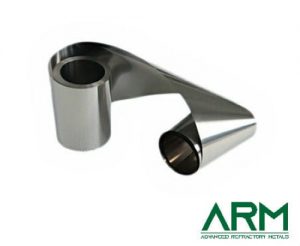Zirconium foil is a highly versatile material known for its outstanding performance in demanding environments. Its unique properties—such as excellent corrosion resistance, high melting point, and remarkable ductility—make it indispensable in a variety of applications across industries, from nuclear energy to aerospace.
Let’s talk about zirconium foil’s key characteristics, manufacturing processes, and extensive applications.

Key Properties of Zirconium Foil
- Corrosion Resistance:
Zirconium exhibits excellent resistance to corrosive environments, including exposure to strong acids, alkalis, seawater, and high-temperature oxidizing conditions. This property is crucial in industries like chemical processing and nuclear energy, where materials are exposed to extreme conditions. - High Melting Point:
With a melting point of 1,855°C (3,371°F), zirconium foil maintains its structural integrity in high-temperature environments, making it suitable for thermal management and high-heat applications. - Ductility:
Zirconium foil’s excellent ductility allows it to be processed into extremely thin sheets, enabling its use in precision engineering and applications requiring exact dimensions. - Low Neutron Absorption:
The material’s low neutron absorption cross-section is essential for applications in nuclear reactors, where it minimizes interference with the nuclear fission process. - Biocompatibility:
Zirconium is non-toxic and biocompatible, making it an ideal choice for medical implants and devices that require both durability and safety.
Manufacturing of Zirconium Foil
The production of zirconium foil involves several carefully controlled steps to ensure its quality and performance:
- Melting:
High-purity zirconium is melted using vacuum arc melting or other advanced techniques to achieve consistency and purity. - Rolling:
The material is rolled into thin sheets or foils under precise conditions, ensuring uniformity in thickness and surface quality. - Annealing:
Heat treatment enhances ductility and relieves stress within the foil, improving its mechanical properties. - Finishing:
Surface finishing processes ensure the foil meets stringent standards for appearance, thickness, and performance, suitable for specialized applications.
Applications of Zirconium Foil
Zirconium foil’s unique combination of properties makes it highly desirable in numerous industries, including nuclear, chemical, medical, aerospace, and electronics.
–Nuclear Energy
Zirconium foil is widely used in nuclear reactors due to its low neutron absorption and corrosion resistance. It serves as cladding for fuel rods, providing a protective barrier between the nuclear fuel and the reactor environment. Its stability under high temperatures and radiation exposure ensures long-term reliability and safety in nuclear energy production.
–Chemical Processing
In the chemical industry, zirconium foil is used in the construction of heat exchangers, reaction vessels, and piping systems. Its resistance to corrosive chemicals like hydrochloric acid and sulfuric acid makes it a preferred choice for harsh chemical environments, ensuring operational efficiency and longevity.
–Medical Devices
Zirconium foil’s biocompatibility makes it essential in the medical field. It is used in surgical instruments, dental implants, and prosthetics due to its non-toxic nature and resistance to bodily fluids. Additionally, its durability and lightweight nature contribute to its reliability in medical applications.
–Electronics
In the electronics industry, zirconium foil is employed in capacitors, resistors, and other components requiring high thermal and electrical stability. Its ability to withstand extreme operating conditions makes it a valuable material for modern electronic devices, including those used in harsh environments.
–Aerospace
Aerospace applications demand materials with excellent thermal resistance and strength. Zirconium foil is used in components like thermal shields, heat exchangers, and engine parts, where it withstands high temperatures and mechanical stress while maintaining lightweight efficiency.
–Renewable Energy Systems
Emerging renewable energy technologies utilize zirconium foil for its durability and efficiency. It is being integrated into advanced battery systems, solar panels, and hydrogen fuel cells, playing a role in developing sustainable energy solutions.
Conclusion
Zirconium foil stands out as a highly reliable material for advanced applications across multiple industries. Its unique combination of properties, including exceptional corrosion resistance, high melting point, and excellent ductility, makes it indispensable in demanding environments. From its critical role in nuclear reactors to its contributions to medical devices, chemical processing, and aerospace technologies, zirconium foil demonstrates versatility and superior performance.
The precision and durability of zirconium foil, coupled with its adaptability for customization, ensure it meets the stringent requirements of modern engineering and industrial processes. As industries continue to evolve, zirconium foil remains a key material for innovation and efficiency, delivering long-term value and reliability in even the most challenging applications.
Why Choose ARM for Zirconium Foil?
Advanced Refractory Metals (ARM) provides high-quality zirconium foil tailored to industry needs. With expertise in manufacturing and customization, ARM ensures that every product meets rigorous standards for performance and reliability. Contact us today to learn how our zirconium foil solutions can enhance your projects.
